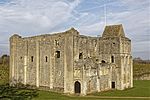Sandringham House is a country house in the parish of Sandringham, Norfolk, England. It is one of the royal residences of Charles III, whose grandfather, George VI, and great-grandfather, George V, both died there. The house stands in a 20,000-acre (8,100 ha) estate in the Norfolk Coast Area of Outstanding Natural Beauty. The house is listed as Grade II* and the landscaped gardens, park and woodlands are on the National Register of Historic Parks and Gardens.
The site has been occupied since Elizabethan times, when a large manor house was constructed. This was replaced in 1771 by a Georgian mansion for the owners, the Hoste Henleys. In 1836 Sandringham was bought by John Motteux, a London merchant, who already owned property in Norfolk and Surrey. Motteux had no direct heir, and on his death in 1843, his entire estate was left to Charles Spencer Cowper, the son of Motteux's close friend Emily Temple, Viscountess Palmerston. Cowper sold the Norfolk and the Surrey estates and embarked on rebuilding at Sandringham. He led an extravagant life, and by the early 1860s, the estate was mortgaged and he and his wife spent most of their time on the Continent.
In 1862 Sandringham and just under 8,000 acres of land were purchased for £220,000 for Albert Edward, Prince of Wales, later Edward VII, as a country home for him and his future wife, Princess Alexandra of Denmark. Between 1870 and 1900, the house was almost completely rebuilt in a style described by Pevsner as "frenetic Jacobean". Albert Edward also developed the estate, creating one of the finest shoots in England. Following his death in 1910, the estate passed to Edward's son and heir, George V, who described the house as "dear old Sandringham, the place I love better than anywhere else in the world". It was the setting for the first Christmas broadcast in 1932. George died at the house on 20 January 1936. The estate passed to his son Edward VIII and, at his abdication, as the private property of the monarch, it was purchased by Edward's brother, George VI. George was as devoted to the house as his father, writing to his mother Queen Mary, "I have always been so happy here and I love the place". He died at Sandringham on 6 February 1952.
On the King's death, Sandringham passed to his daughter Elizabeth II. The Queen spent about two months each winter on the Sandringham Estate, including the anniversary of her father's death and of her own accession in early February. In 1957, she broadcast her first televised Christmas message from Sandringham. In the 1960s, plans were drawn up to demolish the house and replace it with a modern building, but these were not carried out. In 1977, to mark her Silver Jubilee, the Queen opened the house and grounds to the public for the first time. Unlike the royal palaces owned by the Crown, such as Buckingham Palace, Holyrood Palace and Windsor Castle, Sandringham (along with Balmoral Castle in Scotland) is owned personally by the monarch. In 2022, following the Queen's death, Sandringham passed to her son and heir Charles III.











